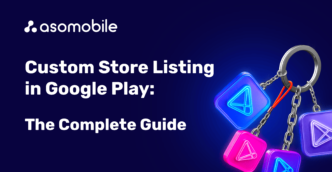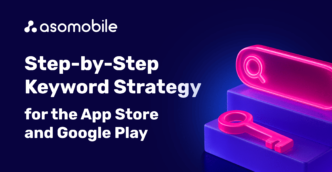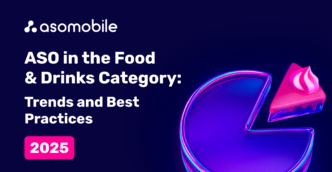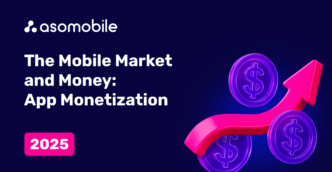Common ASO Misconceptions
In this article, together we will analyze in detail and then brilliantly debunk the Common ASO Misconceptions in order to feel confident and organic on Store Olympus.
These are the basic questions that have given rise to many myths over the years of ASO's existence:
- ASO vs. SEO. Is it the same? And if not, how exactly are they different?
- Keywords in metadata and indexing the application using them. App description on Google Play and App Store. Should I repeat the keys? And if so, how often? Is there a difference in store app descriptions? And if so, what is it? Is description a ranking factor?
- App rating and user ratings. Is it important or not? And if it is, how important?
- Does ASO help you get to the top of search results? And if it helps, then how exactly?
ASO Misconceptions 1 - ASO vs. SEO
Myth: from “ASO and SEO are the same thing” to “they are completely different things.”
Fact: ASO and SEO are almost the same thing. Only the objects differ - for ASO these are mobile applications, and for SEO they are web resources. But they have the same goal for both of them - increasing the visibility of their objects for users.
- ASO (App Store Optimization) - optimization of mobile applications.
- SEO (Search Engine Optimization) - website optimization.
Thus, ASO increases the visibility of applications on mobile markets (Google Play, App Store, Huawei App Gallery, etc), and SEO is focused on promoting a digital product on the global Internet through Google search engines and others like it.
In fact, the founder of ASO was SEO optimization, simply because in the beginning there was a computer and websites. And with the development of technology, mobile phones and products for them appeared - apps.
In 2019, Google noticed that smartphone users form a significant part of Internet traffic. He not only paid attention, but also competently responded to the new market trend - it adjusted the indexing (read: visibility for users) of digital products to mobile-first. From that moment until now, sites that have a mobile version are shown first in search results and only then come their non-adapted counterparts.
But what does this fact tell us about SEO in terms of ASO? Let's use an example.
Here is our application, which, according to all the rules of the genre, is placed on the store, no matter if that is Google Play or the App Store. The user enters a query and runs the search algorithm. Then we have two options for the development of events:
- The application does not have a website - in this case, the search is carried out only on mobile store sites and only among many other similar applications.
- The app is supplemented with a website - then the search is carried out both in marketplaces and on the Internet.
The success of having a web version of the app is confirmed by Google statistics, which tell us that 27% of users find apps inside stores and another 24% on the Internet through websites. The last 24% inspire you to create a web page for the app.
Conclusion: SEO promotes web resources on the Internet, and ASO promotes applications on mobile stores (Google Play, App Store, Huawei App Gallery). ASO is a logical continuation of SEO, only specialized for mobile services. And this gives us the opportunity to use SEO for ASO purposes, by expanding the search not only within marketplaces, but also among websites. The main thing is that the app has this website.
You can read more about SEO capabilities for ASO here.
ASO Misconceptions 2 - Description on Google Play and the App Store
The most common myth: the more keywords you add to the metadata, the higher the indexing will be.
Fact: Actually, no. In some cases, saturating metadata with keys will have the opposite effect.
Why does this suddenly happen this way and where does this misconception come from? Let's analyze together. Let's start with the base:
- Google Play offers us the following metadata fields: title, short description and full description.
- On the App Store these are Title, Subtitle and Keywords.
In both stores, keywords rule the roost. After all, it is by them that stores index our application. We remember that the main point is the relevance of our keys. And now the nuances:
- Google Play indexes by all three fields. All three fields are visible to the user.
In order for Google to know for sure that these specific keywords are relevant to our app, they should be used several times. It is this fact that is misleading. Many people oversaturate metadata fields with keys hoping to get that maximum indexing and therefore higher positions in search results. Practice makes perfect, though in especially severe cases, it makes things worse, so we remember that and do not go too far.
Therefore, we first rank keywords by relevance and importance, and then enter them correctly into the text parts, taking into account the optimal density of occurrence. For a text of 2000 characters, using a key 40 times is a clear imbalance, which, by the way, can lead to a complete lack of indexing for it, even if it is highly relevant. Since we are not at all interested in such a tragic development of events, we use the standard frequency of occurrence, depending on the length of the description - 3% for main keywords, 2% for secondary and 1.5% for the least important keywords.
Life hack: we place the most significant and relevant keys in the first and last paragraphs. This attracts the attention of Google's indexing algorithm.
Additional Google indexing points that we should definitely use: reviews, application URLs, and developer name.
- The App Store, in addition to Title and Subtitle, indexes by the Keywords field hidden from the user, but ignores the description completely, with the exception of using the Apple Search Ads Discovery campaign.
In Keywords we add relevant keywords, without the hassle of literary placing them into the app description and without difficulties with the density of occurrence. But we remember the important point of writing keys correctly, specifically for the App Store. By the way, this is also one of the popular myths, they say, we enter key phrases as they are. But no. In fact, we write the keys in separate words, separated by commas and without spaces between the comma and the next word. For example, we have the following keys: drink water, water meter, drink on time. The correct spelling is: drink, water, counter, water, on time. We don’t duplicate “drink”; Apple understands everything the first time.
The description here is purely informative, but this does not mean that we do not fill it out. This means that we are not limited by indexing like in Google Play and can describe our application for marketing purposes artistically, without being distracted by relevance and keyword density. Such a description does not have a direct effect on increasing the visibility of the application, but it does indirectly affect conversion. And the higher the conversion, the more noticeable the application is for the user. On average, 2% of visitors click on the full description. Therefore, it is worth taking advantage of this free opportunity and filling the description with meaning that reflects the value of our application among others.
We do not miss the opportunity to use additional locales to expand indexing.
Conclusion: do not forget that the best is the enemy of the good. We use keywords correctly and place them in the designated places: Google Play (title, short and full description), App Store (Title, Subtitle, Keywords). We use the sequence: relevance-importance-density of occurrence.
You can learn more about keys, indexing by them and descriptions of applications by looking here.
ASO Misconceptions 3 - App rating and user ratings
Myth: Only the average rating of an app matters, not the number of ratings itself.
Fact: not true. Average ratings, their number, and reviews are worthy of our attention. And that's why.
Although quantity will never replace quality, in the case of mobile apps we must strive for both. The average rating does have a significant impact on installs, but numerous experiments show us that after the release or release of an update, the number of ratings raises the application higher in the search results. Especially if our competitors do not receive such ratings.
Nuances.
A samurai has no goal, only a path. In our case, there have both. The goal is clear as day - to lead the top ratings of stores. But it’s worth paying close attention to the path. An important clarification is on the user path. What is this path? The user enters a query and receives a search result in which they see a list of suitable applications, their icons, names, categories, number of installations, size in MB, publisher's name and average rating. By clicking on the app they like, they go to its page. There they have access to the graphical components of the app (icons, screenshots, videos), description and reviews. Usually, users pay little attention to the description of the application itself, but they pay very little attention to ratings and reviews. It is clear here that the higher the rating and better reviews, the higher the likelihood of installation.
Many people believe that the main tasks of ASO are keywords and experiments. And these things are really necessary and important. But an equally important aspect of success is a convenient and relevant user journey.
By the way, market algorithms also take into account ratings and reviews when ranking apps.
Conclusion: There is nothing unimportant about ASO. Both the app rating and its average rating, along with the number of ratings and reviews, affect the app's position in its search results.
Here you can find detailed information about ratings, ratings and reviews.
ASO Misconceptions 4 - Does ASO help you get to the top of search results?

Myth: a good, high-quality, useful (underline as appropriate) application does not need optimization. An excellent product will always find its customer.
Fact: Actually, no. Why?
Because apps don't sell themselves. They need to be sold. And because without ACO, any wonderful app will simply be lost among many similar ones.
Above we talked about the user journey, the final goal of which is installing our app. This is exactly what ASO does. Proper optimization of the app allows users to find our product in markets and brings users from web search, social networks, and e-mail.
Here are three main pillars that you should think about in advance, even before launching the app:
- Keywords should effectively and informatively describe our app to a potential user.
- Creatives: (visual components) - should be interesting, bright, enticing.
- Strategy: what steps need to be taken to increase the visibility of the application and satisfy users
Conclusion: we all know that advertising is the engine of trade. In the case of an app, it is also an engine. But there is a difference in what and how we move. Advertising alone is not enough. ASO is responsible for what and how we move. A well-thought-out ASO strategy is needed, and then the first lines of the top charts will be ours.
And last but not least: let’s briefly mention a few more misconceptions that wander around the mobile industry:
- Myth: App visibility can be ensured by paid traffic, without any optimization.
Fact: It can't.
No financial investment in advertising or attracting paid users alone, without ASO, will guarantee first place in the ratings of mobile stores. Because ACO works not only for organic experience, but also for supporting paid marketing campaigns.
- Myth: You need to buy targeted traffic. Especially if you are a mid-level publisher and have to compete with recognizable and well-known brands.
Fact: No. Moreover, such a purchase involves considerable risk for the application and its developer.
When a potential user is offered discounts, rewards, and in particularly difficult cases, even payment for installing an app, this is motivated traffic. This kind of traffic is popular with small and medium-sized publishers. There is an opinion among them that this way they can attract a large clientele in a short time. But there is a flip side to the coin - if Google Play or the App Store detects such traffic, then there is a high probability of blocking the app and the developer’s account, up to and including complete removal from the marketplace.
It is better to use referrals or word of mouth - it is both quite effective and completely safe.
- Myth: Small and medium-sized publishers don't need their own brand.
Fact: No.
Good for those brands that are popular in the offline world. It is much easier for them to win over their users online.
But many apps focus on their app's services themselves rather than their branding.
For example, a PDF application. Here PDF is both a keyword and a user request. At the start, the simple name PDF editor will give the desired benefits. But in the long run, branding is a better strategy. An unmemorable PDF editor will be deleted immediately after use, but a branded one will be remembered and remain in the user’s smartphone. After all, it has a unique name, appears at the top of search results, is remembered, and it’s just too lazy to search for and download its nameless brothers every time. Moreover, more and more often users are looking for specific brands, and not just functionality and services.
Check the myths, use ASO to the fullest, and may our application top the market ratings!
 Українська
Українська  Русский
Русский  Español
Español 






